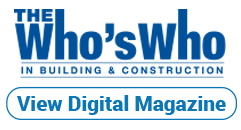All the Right Connections
East Coast Rigging & Scaffolding majors in high-level access

At Langley Air Force Base in Hampton, VA, a custom-designed scaffold access and enclosure helps protect and restore every inch of an F-15 Eagle fighter aircraft.

Mark Kerner, East Coast Rigging & Scaffolding Founder and President, formed the company in 1991.
Mark Kerner, Founder and President of East Coast Rigging & Scaffolding (ECRS), is in the business of getting contractors to work.
Simple enough, you’d think, until the work site is underneath the center span of a suspension bridge; or on the 60th-floor exterior of a glass-skin building; or near a chandelier stories above a church altar with centuries-old pews. In cases like these, which dominate the ECRS docket, the route to a work site has to keep construction workers safe and secure as it also protects the site’s physical surroundings.
Mark laughs. “One of our top salesmen gave us our mantra: Preferred provider of difficult-access solutions.”
Asked to list some of those solutions, Mark and his Chief Operating Officer Andy Kerner, also his oldest son, tick through examples. “A lot of bridges,” Mark begins. “When there’s water under it, you obviously can’t build from the ground up. You have to hang down from above.”
Showcase in point, the Chesapeake Bay Bridge in Maryland—aka the scariest bridge in America—a four-mile testament to ECRS ingenuity. Some of the scaffolding sections are movable work decks. Others call for a cable enabling an inspector to traverse the structure to judge for wear and tear—or where critical repairs are needed.
“In some of those cases, we hung platforms 40 feet long by 40 feet tall from the structural steel,” Andy says. “Our customers repaired the concrete and applied weather sealant so we can all use the bridge for many more years to come.”
State of Repairs
At any given time in Maryland, Andy says, ECRS is at work on five to 10 bridges, ensuring safe access for infrastructure repair and inspection work. In Annapolis, beneath what locals still call the Severn River Bridge—renamed the Pearl Harbor Memorial Bridge in 2006—ECRS installed a walkway the length of the bridge. “About 2,860 linear feet of scaffolding,” Andy says, nearly 10 football fields long, including endzones, which ECRS put up in nine weeks.
Repeat: Nine weeks. For that kind of speed on top of safety, Mark credits their “small to mid” size, which tallies $15 million a year in billings. ECRS customers—contractors and managers of every size project—come for the quick responses, Mark says. “We care about their work and what they need to do to get it done, and they know it.”
Andy’s legal expertise, meanwhile, streamlines agreements and procedures. “We lack the bureaucracy of a larger organization and give the personal attention of a family business,” he says, simply. “From the time we get a request for a quote, to when the job is installed, we’re usually faster than our competitors.”
At the Smithsonian Institution, an ECRS structure may lead around, over or through exhibits for contractors to reach ceilings for sprinkler, acoustical or electrical work. In high-end homes, ECRS’ lightweight scaffolding cleverly respects its surroundings as it gets workers to stories-high lighting, often ending with more good stories.
“Difficult access lends itself to creative thinking to do it safely,” Andy says.
Going High and Keeping Up
Job-to-job differences keep ECRS current on the latest technology and machinery. “We had a project in Arlington,” Andy begins. “The roof was mansard, so no swing stages.” No hanging a worker’s platform by cables from rigging installed on the roof. So to go where no contractor had gone in years, ECRS invested in a highly portable mast-climber innovation called ReechCraft PowerMast. Contractors could rise, lower and wrap around corners of a 200-foot-tall senior living facility to demolish, clean and/or repair every square foot of the brick facade.
Closing the gap between sites and contractors who work them also means keeping the contractors’ tools and products handy. “We have a dozen different products for them to perform their work safely and efficiently—trash chutes, roof-edge protection, scaffolding, shoring, swing stages, mast climbers and personnel and material hoists,” Andy says. “If there’s a demand, we invest, install and put it out for rent.”
The Story in the Name
ECRS was founded in 1991 to help companies get hard-to-move objects from points A to B. Early projects ran from bridges to power plants. “That was the rigging—moving equipment into and through buildings,” Mark says. “For anything a crane couldn’t install, we’d find another way.” Think tanks, printing presses, generators, gear for electrical contractors. On the outside of high-rise buildings, ECRS suspended platforms for contractors to re-caulk, restore or anything else. They built suspension platforms for a well-known maker of jet-propulsion engines. And in it all, the future was showing.
“The more we did, the more we solved; the more we solved, the more we could build to any customer’s needs,” Mark says. “We’d see what our contractors needed and meet any challenge. In the late ‘90s we started buying system scaffold.”
And with scaffolding the company changed, in Mark’s words, “from working with brick contractors to pretty much anyone,” meaning general construction subcontractors and “all the additional subs”—glazing, drywall, concrete restoration and more.
CIA to ECRS
Mark grew up near Bethesda, Maryland, and earned a college degree in accounting and business. Out of school he worked for the CIA in photography and later in logistics. When he left the government, “I jumped into a job selling burglar alarms,” he says, until an alarm customer hired him for his rigging company. Four years after that, Mark formed ECRS as a rental business, which began with rigging—buying equipment still in use 30 years later.
While Mark was building a business, he was also building a family. He and his wife are the parents of seven sons, all of whom grew up in the shadow of rigging and scaffolding. Four are at ECRS, starting with Andy, an attorney who traded law clients for businesses that build the world.
“He came to work for me five years ago and has doubled the size of the company,” Mark says. “I built a strong foundation; he built off that, investing the money and diversifying the work.”
Kerner son number two, Pat, runs complex projects for the company. Number three, Chris, handles scheduling. Number four is a Marine pilot on the West Coast. Five just graduated with a degree in animal science and supervises the yard. Number six, with plans to be a physician, works summers at ECRS. The youngest is in college studying wildlife management.
Solution Seekers
By definition, a family business blurs the line between home and work, using values that serve both. For the Kerners, that means taking care of customers as if they were family, their unofficial mission statement.
Andy puts it most simply. At the end of the day, it’s about safety, he says. You can put up whatever access you want but workers have to get there, do their work and go home. Given that most of their work is 50 feet high or higher, ingenuity has to serve safety first.
“It’s construction, and it’s problem-solving,” Mark adds. “We figure out how to do it, and how to do it safely, and it takes constant innovation. Our competitors are evolving. Safety standards are evolving. To be cost effective, we have to be smarter—and safer—at every level.”


 Login / Register
Login / Register

